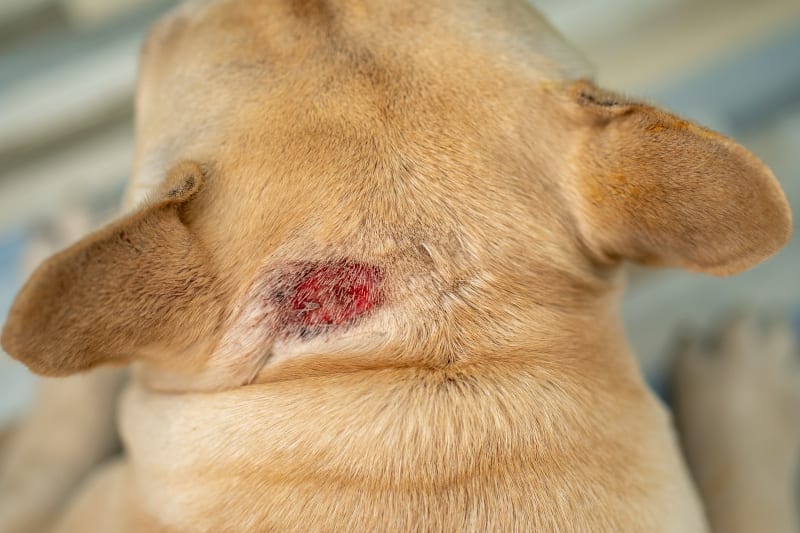Dermatitis is a common but often frustrating skin condition that affects many dogs. Characterized by inflammation, redness, and itching, it can cause significant discomfort for your pet and often goes unnoticed until symptoms worsen. Over 10% of dogs experience some form of dermatitis during their lifetime, making it important for pet owners to understand this condition and know how to effectively treat it. Timely intervention is crucial, as untreated dermatitis can lead to infections, pain, and long-term health issues. In this article, we’ll explore how to identify dermatitis, its causes, and the most effective remedies to treat and manage this condition.
Understanding Dermatitis in Dogs
To provide your dog with the best care, it’s essential to understand what dermatitis is and how it manifests. Dermatitis, simply put, refers to inflammation of the skin. It often starts with mild itching but can quickly escalate to severe discomfort, especially if the skin becomes irritated by constant scratching or biting. Dogs, like humans, are susceptible to different types of dermatitis. The most common forms include allergic dermatitis, atopic dermatitis, and contact dermatitis. While allergic dermatitis is triggered by reactions to environmental factors or food, atopic dermatitis is often linked to genetic predisposition and long-term exposure to allergens such as pollen or dust. Contact dermatitis occurs when the skin comes in contact with an irritant like certain plants, chemicals, or even shampoos. Understanding these types will help you identify which treatments might be most effective for your dog’s specific condition.

Recognizing the Symptoms of Dermatitis
Knowing the symptoms of dermatitis can make a significant difference in how quickly you can intervene and relieve your dog’s discomfort. Early signs can range from persistent scratching, biting, or licking to more visible symptoms like red, inflamed skin or hair loss. Some dogs develop dry, flaky patches or moist, infected areas known as “hot spots.” Bad odor or swelling can indicate secondary bacterial or yeast infections, which are common when dermatitis goes untreated. Your dog may also show signs of behavioral changes, such as restlessness or reluctance to play due to discomfort. Identifying these symptoms promptly will allow you to implement treatments before the condition worsens, minimizing your pet’s suffering and preventing further complications.
Common Causes and Triggers
Understanding the root causes of dermatitis is vital for effective treatment. The most frequent culprit is an allergic reaction, either to environmental factors or food. Fleas are a common trigger for dermatitis, particularly in cases of flea allergy dermatitis, where even a single flea bite can cause a severe reaction. Environmental allergens such as pollen, mold, and dust mites also play a significant role, particularly in atopic dermatitis. Food allergies, while less common, are still a major concern and are usually caused by proteins in dog food, like beef or chicken. Other causes include direct contact with irritants like harsh shampoos or cleaning products, which can trigger contact dermatitis. Additionally, poor grooming or untreated wounds can increase the risk of infections that exacerbate the skin condition.

Diagnosing Dermatitis
When it comes to dermatitis, proper diagnosis is key to successful treatment. Visiting a veterinarian is crucial, as only they can accurately determine the type of dermatitis your dog is suffering from. Diagnosis typically starts with a thorough physical examination and review of your dog’s medical history. Vets will assess the skin, looking for areas of inflammation, redness, and signs of infection. Diagnostic tools like skin scrapings or cytology may be used to identify parasites, bacteria, or yeast. Allergy tests, either through blood work or intradermal testing, are often recommended to pinpoint specific allergens. If food allergies are suspected, your vet may advise an elimination diet to identify which ingredients are triggering the reaction. In severe or chronic cases, a biopsy may be necessary to understand the extent of the condition and develop a targeted treatment plan.
Effective Remedies for Treating Dermatitis
Once diagnosed, treating dermatitis often requires a combination of approaches, and each dog’s treatment plan may differ based on the severity of the condition. Topical treatments are among the first lines of defense. Medicated shampoos, especially those containing ingredients like chlorhexidine or ketoconazole, can soothe inflamed skin and eliminate infections. Bathing your dog regularly with these shampoos helps keep the skin clean and reduces itching. Additionally, topical ointments or sprays containing soothing ingredients such as aloe vera or hydrocortisone can help alleviate itching and swelling. These treatments are often essential for managing dermatitis symptoms on a day-to-day basis.

Dietary changes also play a crucial role in treating dermatitis, particularly in cases caused by food allergies. Switching to hypoallergenic dog food or implementing an elimination diet helps in identifying and removing the allergen causing the reaction. Omega-3 fatty acids, often found in fish oil supplements, are beneficial in reducing inflammation and promoting healthier skin. For dogs suffering from flea allergy dermatitis, maintaining strict flea control through oral or topical medications is critical. Flea preventatives can eliminate one of the most common triggers of dermatitis and significantly improve your dog’s quality of life.
In some cases, prescription medications may be required. Antihistamines can help relieve itching, while corticosteroids are often prescribed for more severe inflammation. For dogs with bacterial or fungal infections secondary to dermatitis, antibiotics or antifungal medications are necessary. Immunotherapy, which involves administering allergy shots to reduce sensitivity to allergens, is another long-term solution for dogs with chronic allergic dermatitis.
Natural Remedies and Home Management
In addition to conventional treatments, several natural remedies can help manage dermatitis at home. Coconut oil is an excellent moisturizer that can be applied directly to the skin to reduce dryness and soothe irritation. Chamomile tea soaks are another natural remedy that can help calm inflamed skin. You can prepare a chamomile tea solution, let it cool, and use it to rinse your dog’s affected areas. For dogs with milder forms of dermatitis, diluted apple cider vinegar spray can be applied to itchy areas, although it should never be used on open sores or lesions.
Making your home environment more comfortable for your dog is equally important. Ensure your dog’s living space is clean and allergen-free. Regularly wash their bedding and toys, and consider using air purifiers to minimize environmental allergens. Additionally, providing your dog with a balanced diet and maintaining a proper grooming routine can help prevent dermatitis flare-ups.
Preventive Measures
Preventing dermatitis is always better than treating it, and adopting a few key preventive measures can significantly reduce your dog’s risk of developing this condition. Regular grooming is one of the most effective ways to maintain healthy skin and coat. Brushing your dog removes loose fur, dirt, and allergens, while regular baths with mild shampoos prevent skin irritation. Ensuring your dog follows a balanced diet rich in omega-3 fatty acids and other skin-supporting nutrients is equally important. These nutrients promote a strong immune system and a healthier coat, making your dog less susceptible to skin conditions.
Monitoring your dog’s environment is also crucial. Try to minimize exposure to potential allergens, especially if your dog is prone to seasonal allergies. Regular veterinary check-ups ensure that any skin conditions are caught early, allowing for prompt treatment and preventing the condition from escalating. For dogs prone to dermatitis, these preventive measures can make all the difference in maintaining their skin health.
When to Seek Veterinary Help
Although many cases of dermatitis can be managed at home, it’s important to know when to seek veterinary care. If your dog’s symptoms persist despite home treatments or if they worsen, professional help is essential. Severe cases of dermatitis, especially those involving open sores, significant hair loss, or signs of infection, require immediate attention. Early intervention by a veterinarian can prevent long-term damage and reduce your dog’s discomfort. Regular veterinary check-ups are also critical for managing chronic dermatitis and ensuring that your dog receives the appropriate treatment.
Treating dermatitis in dogs may seem daunting, but with the right approach, it is possible to provide relief and improve your dog’s quality of life. By understanding the causes and symptoms, implementing effective remedies, and taking preventive steps, you can manage your dog’s condition and keep their skin healthy. Whether using medicated shampoos, adjusting their diet, or incorporating natural remedies, consistency and timely intervention are key to successful treatment. Always remember to consult with your veterinarian for a tailored treatment plan, ensuring your furry companion stays comfortable and happy, free from the discomfort of dermatitis.

After 5 years in a high pace business management role, I partnered with an e-commerce developer to start building Dog Supplies Warehouse.
Our number one goal is to make sure all products are managed and delivered to our customers door fast and accurately.
